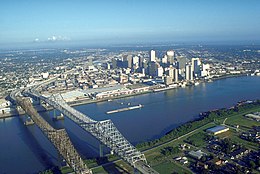Frank M. Masters
Frank Milton Masters (born June 18, 1883 in Meyersdale , Somerset County , Pennsylvania , † February 7, 1974 in Harrisburg , Pennsylvania) was an American civil engineer and metallurgist . After completing his studies, Masters worked under Ralph Modjeski from 1904 , in the meantime ran his own engineering office and became Modjeski's partner in 1924. In 1936 he took over the joint engineering office Modjeski & Masters , which still exists today and is still involved in the construction and maintenance of bridges.
Life
Frank Milton Masters was born on June 18, 1883 to Clarendon Gideon and Eliza Masters (née Beachly) in Meyersdale , Pennsylvania . Masters graduated from Mercersburg Academy after school , took preparatory courses at Cascadilla School in New York, and then went to Cornell University . He also visited the Carnegie Technical Schools and specialized during his studies from 1900 to 1904 as a civil engineer (civil engineer) and metallurgist (metallurgical engineer) .
After completing his studies, Masters worked in various positions under Ralph Modjeski in Chicago , Pittsburgh and New York City , where he now ran his own engineering office. From 1917 to 1919 he served as a major in the Ordinance Department in the United States Army and then reopened an engineering office in Harrisburg . In 1924 he became a partner of Ralph Modjeski and built a large number of bridges with him by the mid-1930s. In 1936 Masters took over the engineering office Modjeski & Masters (Modjeski died in 1940), which he managed until his retirement in 1972. It persists to this day and is still engaged in building and maintaining bridges.
Frank Milton Masters married Margaret Eleanor Wilson in 1925, with whom he had two children, Frank Milton and Margaret Ann. Frank Milton, Jr. became a civil engineer like his father and worked under him at Modjeski & Masters . The family had lived south of Harrisburg in Heckton since 1929 . Masters, Sr. died on February 7, 1974 at the Polyclinic Hospital in Harrisburg, aged 90 .
plant



Frank M. Masters realized with Ralph Modjeski and after his death as senior partner of the engineering office Modjeski & Masters over 20 bridges in the United States. Frank M. Masters learned from Modjeski, who in turn gained his first experience under George S. Morison (1842-1903), which is particularly evident in the three neighboring bridges over the Mississippi River in Memphis : Ralph Modjeski was responsible for the design of the Frisco Bridge (1892) involved under Morison, Frank M. Masters worked under Ralph Modjeski on the Harahan Bridge (1916) and realized the Memphis – Arkansas Bridge in 1949 as head of the Modjeski & Masters engineering office . Modjeski was also chief engineer for the construction of the Québec Bridge (1917), the longest cantilever bridge in the world, and Masters built the third longest of the time with the first Crescent City Connection (1958) as well as the Newburgh – Beacon Bridge (1963) and the Horace Wilkinson Bridge (1968) three of the twenty largest cantilever bridges in relation to the span .
In addition to many truss bridges , Modjeski built the Benjamin Franklin Bridge (1926), one of the world's longest suspension bridges, and Masters emulated him with the neighboring Walt Whitman Bridge (1957) in Philadelphia . Modjeski & Masters also realized several additional road bridges parallel to the existing bridges originally designed by Modjeski or Masters, including the second bridges of the Iowa – Illinois Memorial Bridge (1935 and 1960), the Newburgh – Beacon Bridge (1963 and 1980), the Crescent City Connection (1958 and 1988) and the Blue Water Bridge (1938 and 1997).
Frank M. Masters life's work has been recognized by the American Society of Civil Engineers with the Frank M. Masters Transportation Engineering Award since 1976 , of which he was an honorary member. It recognizes outstanding plans, designs or implementations in the field of transport - infrastructure .
Web links
- Modjeski and Masters.
- Guide to Modjeski and Masters Company Records. Archives Center, National Museum of American History, Smithsonian Institution . Retrieved January 14, 2018.
Individual evidence
- ↑ Jozef Glomb, Peter J. Obst (trans.): A man who spanned two eras: The story of bridge engineer Ralph Modjeski. The Philadelphia Chapter of the Kosciuszko Foundation, 2002, ISBN 0-917004-25-6 , pp. 45 f.
- ↑ a b Who's who in Commerce and Industry. Volume 14, Marquis Who's Who, Chicago 1965, p. 844.
- ^ Frank M. Masters Devoted His Skill to Local Bridge. Maysville's Daily Independent, November 25, 1931 (on Northern Kentucky Views ). Retrieved January 14, 2018.
- ↑ Jozef Glomb, Peter J. Obst (trans.): A man who spanned two eras: The story of bridge engineer Ralph Modjeski. The Philadelphia Chapter of the Kosciuszko Foundation, 2002, ISBN 0-917004-25-6 , pp. 71 f.
- ↑ We do the right thing. Modjeski and Masters. Retrieved January 14, 2018.
- ↑ Frank Griggs: Ralph Modjeski. In: STRUCTURE magazine. January 2013. Retrieved January 14, 2018.
- ↑ a b Frank Milton Masters. Prabook, World Biographical Encyclopedia. Retrieved January 15, 2018.
- ↑ Barbara Miller: Connections: Heckton features river views and long, rich history. PennLive, October 13, 2011. Retrieved January 15, 2018.
- ↑ FRANK MASTERS SR., BRIDGE DESIGNER, 90. The New York Times , February 8, 1974. Retrieved January 14, 2018.
- ^ Frank M. Masters Transportation Engineering Award. American Society of Civil Engineers, accessed February 8, 2018.
| personal data | |
|---|---|
| SURNAME | Masters, Frank M. |
| ALTERNATIVE NAMES | Masters, Frank Milton |
| BRIEF DESCRIPTION | American bridge construction engineer |
| DATE OF BIRTH | June 18, 1883 |
| PLACE OF BIRTH | Meyersdale , Pennsylvania |
| DATE OF DEATH | 7th February 1974 |
| Place of death | Harrisburg , Pennsylvania |